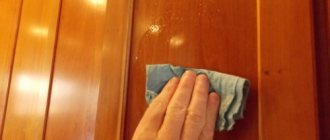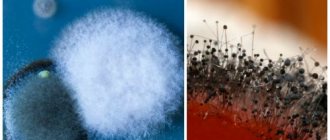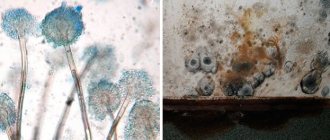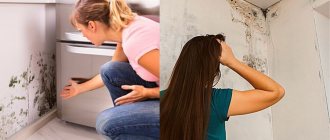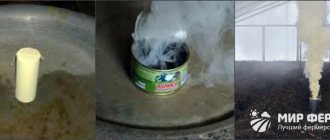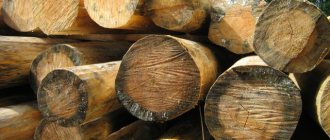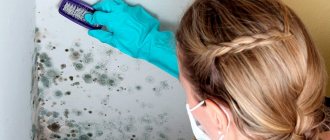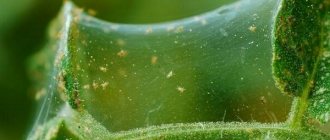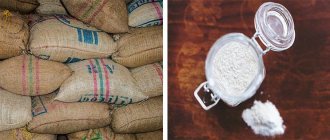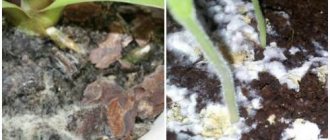This question arises most acutely for a person when he or she encounters black mold in the house. From that very moment, the study of theory and the acquisition of practical skills to combat the scourge begins. Below you will receive both theoretical and practical knowledge.
In the article you will discover such information as: types of mold, features, reasons for its appearance and growth, and why it is dangerous directly for humans. The fungus is very insidious and if you do nothing or take the wrong actions, it can take over more and more territories and greatly worsen the quality of life. At the end, we’ll tell you how to get rid of mold forever and prevent its reappearance in the house.
What is mold
Mold, also known as mold (belongs to the kingdom of fungi) is one of the most ancient forms of life on Earth. Visually perceived by humans as a coating or growth on organic, synthetic and mineral surfaces. It can appear and settle on absolutely any surface and even in space on the ISS. The plaque consists of branching outgrowths of mycelium and spores and does not contain large fruits. Due to the fact that mold spreads not only on surfaces, but also penetrates into objects, it can be extremely difficult to get rid of. Some species are extremely resistant to any temperature changes, and even to radiation.
Microorganisms that can be observed on the affected areas with the naked eye are colonies, most often formed in a warm and humid environment.
Return to content
Mold damage and first aid
Different types of mold can cause varying degrees of harm to the human body - from mild illness and allergies to severe pulmonary diseases, poisoning and even cancer.
- Yellow mold is the most dangerous, as it contains the poison aflatoxin, which is resistant to heat treatment and is very dangerous for humans.
- This poison can cause asthma, bronchitis, and cardiovascular diseases.
- White and green mold are not so dangerous, but they can also cause allergies and poisoning.
- Black mold can cause severe lung diseases, including cancer.
- Some types of mold can even cause death.
In case of mold damage, treatment is carried out with absorbent substances (for the gastrointestinal tract) and antifungal drugs. It is also necessary to support the functioning of the kidneys and liver and restore the intestinal microflora. For this purpose, special medications and a diet with the addition of natural antioxidants are prescribed.
Types of mold
There are more than 200 thousand species of mold, which are united by the kingdom of fungi. Man has learned to use certain species for his own purposes - making antibiotics, cheeses, wine, citric acid, various sauces, and other food products. But there are other representatives of mold fungi that pose a real threat to human health and life.
Color is not a classification of mold, but there are nuances.
White mold
Due to its appearance, white mold does not look scary, but it still poses a certain danger.
Can be detected on the soil surface, including in pots with indoor plants, on plants, trees, wooden products and building materials, and on products. In rare cases, it forms on walls in residential premises and quite often in basements with high humidity and poor ventilation.
Certain strains of white mold, referred to in everyday life as “noble mold,” are used in cooking, for example, they are used to make gourmet cheeses - Brie and Camembert. Not to be confused with ordinary white mold, which produces compounds that are toxic to humans.
Mold with a white tint can occur in the following genera:
- Sclerotinia (lat. Sclerotinia) - most often affects crops and trees.
- Aspergillus, also aspergillus (lat. Aspergillus) - grow on the surface of plants, food products, trees, as well as on damp walls indoors.
- Penicillium (lat. Penicillium) - this genus has both useful species that are used in cheese production and pharmacology, and toxic ones that pose a danger to human health, sometimes found in apartments.
- Mucor (lat. Mucor), also white mold, is widespread in the surface layers of soil, on food and food waste. Some species pose a health hazard, others are used in pharmacology and as a starter and for the production of ethanol from potatoes.
White mold on the surfaces of buildings can systematically destroy finishing and building materials, and in residential areas its presence is a direct threat to human health.
If white mold is found in a house on the walls, floor or ceiling, it is extremely difficult to get rid of it; it is necessary to urgently take measures to remove it, and it is important to use personal protective equipment.
The most dangerous mushroom for wooden buildings is the white house mushroom (lat. Serpula lacrymans). In ancient times, if this type of mold was found in a wooden house, the house was immediately burned to prevent infection of other buildings in the village; in just a month, the fungus was able to destroy all the wood in its reach.
Return to content
Green mold
Penicillium (lat. Penicillium) has a number of types of fungi that are green or have a greenish tint. Most often, green mold affects food and fresh fruit. Many members of this genus have the ability to inhibit the growth of bacteria (antibacterial effect), as a result of which the first antibiotic Penicillin was produced.
However, beneficial microorganisms have nothing to do with green mold inside buildings, on walls or ceilings. Green mold indoors poses a threat to the body, especially for children and the elderly. If detected, it is necessary to take measures to remove plaque.
Black mold
The black color of mold may not appear immediately; it depends on the type, stage of development, and the structure of the surface on which the colony is located.
Most often, the question of how to get rid of black mold is asked by residents of houses and apartments, since it is the most harmful and common in everyday life. It can grow wherever there is a favorable environment - on wallpaper, tiles, plastic, floors, ceilings, wooden objects, cellophane, etc.
The most common type of black mold in a home or apartment is the species Aspergillus niger (Aspergillus black). However, only a specialist using a microscope can accurately diagnose the name of the species. To obtain the result of a laboratory test, you can take a sample and take it to the nearest laboratory of the State Sanitary and Epidemiological Service.
On the wall, in a damp room, other types of black molds can also develop; for this, it is enough for only 1 spore to enter the room and you need to create favorable conditions for it. The rate of mold growth depends on the type and environmental conditions, primarily temperature, humidity, lack of air ventilation and ultraviolet radiation. If all conditions are met, the reproduction rate will be simply fantastic.
Cases have been recorded when black mold penetrated deep into the wall, people removed wallpaper, plaster, cleaned the brick, made repairs, and after a week the growth continued, the walls not only turned black, but were covered with 3-5 centimeter layers of black growth at incredible speed.
Return to content
Mold blue
Dangerous only for wood and wooden surfaces - window frames, furniture, wooden floors, parquet. Caused by various types of mold. A characteristic feature is a change in color to a darker one with gray-blue shades.
The blue fungus itself does not harm the strength of the tree, since these microorganisms feed only on easily decomposed substances and do not destroy the wood substance. But, blue mold, like other species, collects moisture from the air; over time, the moisture content of the wood increases, which ultimately creates conditions for the activation and reproduction of other, more dangerous species. Blue fungus can also damage protective coatings of wood, which affects the aesthetic appearance and protective properties.
mold rotting
It is dangerous, just like blue stain, exclusively for wood and wooden structures, but unlike blue stain, rot destroys the structure of wooden structures. Depending on the type, the consequences can be very different - from discoloration and cracks, to cracking and complete destruction. In any case, the density of the tree is disrupted and over time the fungus completely “eats” the tree or wooden product.
Return to content
Mold in the bathroom: a little theory
If we consider the issue from a biological point of view, then mold is a large colony of mold fungi, which are widespread today. Their distinctive feature is that they are able to multiply rapidly and produce toxic microspores. Those, in turn, fly through the air, settle on all kinds of surfaces, forming plaque, and, once in a favorable environment, they themselves sprout into fungi.
Why should you be concerned about the question of how to get rid of fungus in the bathroom if you spend most of your time in the apartment in the living rooms? The answer is simple: if toxic particles affect the respiratory tract or circulatory system, it can develop into anything from headaches to damage to internal organs. However, there is also no need to create a whole tragedy because of the appearance of a small dark spot on the tile. Before you get rid of mold in the bathroom, determine what type it is and whether it really poses a danger.
Main places where mold spreads
Mold can live and actively reproduce on any surface where conditions are created for this. The so-called household mold thrives on any surface - organic matter (plants, food products), mineral materials (plaster, brick, aerated concrete, cinder block, granite), on soil and even on metal.
You need to understand that mold spores are so small that the human eye simply cannot see them; they are lighter than spider webs that are carried by the wind. Controversy is in the air. They can easily be brought into the house on clothes, in hair, or by pets. Next, the fungus settles on the surface and as soon as the conditions for its growth coincide, it becomes active and the reproduction process begins.
The most suitable places in the house for mold are water pipes, window frames, bathrooms with poor ventilation, external walls in private houses covered closely with furniture, food products, corners of rooms where ventilation is weakest, etc.
Mold may also appear in the car. This occurs due to moisture getting into the interior, as a result of damaged sealing rubber bands or an error when installing drainage from the windshield and its components (sealing rubber bands, plastic parts, etc.). Especially in winter, it is necessary to remove rubber mats from the floor of the car and dry all wet areas thoroughly.
Under ideal conditions, the reproduction cycle from spores to new offspring takes 1-2 days, that is, with 1 m² infected, after 2 days 2 m² will be infected.
Moreover, experiments were carried out with mold in outer space, as it turned out, even in extreme conditions of outer space (radiation, vacuum, extreme temperatures), mold goes into “hibernation”, and when environmental conditions become favorable again, the fungus becomes active and begins actively reproduce.
Return to content
Causes of fungus on walls
Fungus occurs for many reasons. The main ones are the following:
- Ventilation problems;
- Excessive humidity;
- Sewerage malfunction;
- Uninsulated walls;
- No heating;
- Lack of insulation between foundations;
- Incorrect brick laying.
To avoid the appearance of fungus, you need to carefully monitor the microclimate in the room and also check the ventilation. Ventilating the room is also considered a preventive measure against fungus, so it is necessary to do this at least 2 times a day.
What mold should you be wary of?
There are more than 200,000 types of mold in the world and approximately 25% of the total are dangerous to humans, and this is about 50,000 species - an impressive number.
Under no circumstances should you eat food that is already moldy. Even if you decide to cut off the part that visually appears in the form of plaque, you need to understand that the entire product is permeated with mycelium (the root system of mold) and harmful substances will certainly enter the body. This applies to any food products, with the exception of those in the production of which the so-called noble mold was used (cheeses, wines, etc.). Products that are affected by fungus should be disposed of immediately.
No less dangerous is the mold that develops on the walls; it can be of different colors - gray, black, green, white. During the process of reproduction, a huge amount of spores and microtoxins are intensively and regularly released into the air, which can lead to respiratory diseases, a weakened immune system, and diseases of the lungs, kidneys, liver, heart and other organs.
If a mold grows on a houseplant, it destroys the flower; if the fungus grows in a greenhouse, the entire ecosystem may die.
Return to content
Disadvantages of DIY mold removal
- A person who does not have experience in such work is deprived of the necessary knowledge. Namely, disinsection requires strict adherence to safety precautions, as well as the correct choice of means. When choosing it, an inexperienced person is forced to rely only on commercial advertising or advice from outsiders. But you should understand that neither the first nor the second source of information takes into account your real situation with its features.
- When choosing a means of destruction, a person can turn to traditional methods or to specialized preparations from a hardware store. There are really good drugs in both groups of drugs. However, each also has disadvantages.
If we talk about folk remedies, then, as a rule, the effect produced is temporary. It is very rare to achieve complete elimination of fungal spores.
As for purchased drugs, you will have to choose between saving time and saving health. The fact is that all such remedies are divided into instant-acting and prolonged-acting ones. The former mainly include potent drugs. If you choose such a spray, you will have to evacuate the family from their apartment for several days - until the toxic fumes completely disappear from the premises. Needless to say, not everyone has such an opportunity.
If you resort to long-acting agents, you will need a lot of luck. It is difficult to predict which remedy will be suitable for your situation.
Why does mold appear?
A person notices mold-affected areas (colony) at the stage of active reproduction, and many make the mistake of starting to remove the consequences, but do not pay attention to or completely miss the cause.
A colony can form from just 1 spore brought into the house on clothing or during ventilation. It is impossible to completely protect your home from spores, since they cannot be seen with the naked eye.
To start the process of active reproduction of a colony of only 1 spore, the following factors must coincide:
- increased humidity
in the room and individual objects, for example, a leak in a water pipe, in the heating system, accumulation of condensation, a damp wall, drying clothes in a room, a crack in the floor or in the joints of furniture where moisture accumulates, freezing of walls. - Lack or poor ventilation, air stagnation. Often mold appears on plastic windows in the 2nd or 3rd year of operation, when the ventilation ducts become clogged. Black mold can also be observed in the bathroom when the ventilation ducts are clogged; in this case, the humidity in the room increases many times over; it simply has nowhere to go.
- No exposure to ultraviolet radiation (
of secondary importance indoors). The sun burns mold with direct rays; where the sun's rays hit, the fungus cannot exist.
If the colony has reached an impressive size, then it begins to accumulate moisture at the place of growth, thereby creating optimal conditions for reproduction and increasing the humidity in the room as a whole.
Return to content
Description and characteristics
Mold multiplies quickly, and if you start the problem, it will be more difficult to get rid of it
Mold is microscopic fungi that form on surfaces (ceilings, flooring, walls), between tiles in the bathroom, wood, even in food. Has different colors: black, blue, white.
The fungus appears in warm rooms saturated with moisture, where there is no ventilation and no air circulation
In 1 day, a fungal spore spreads over a square meter. Inhalation can cause chronic asthma, bronchitis, allergies, skin diseases, nausea and headaches.
It is forbidden to touch fungal plaque without protective gloves. Otherwise, the spores will enter the body and begin to multiply.
If the case is advanced, internal bleeding and liver damage may begin.
How to get rid of mold at home
First of all, before you begin the process of removing mold with your own hands at home, you need to protect yourself, for this you need to wear at least gloves, safety glasses, a respirator and a change of clothes. These are necessary measures for three reasons:
- Mold release products can be toxic, so breathing in the spores is not recommended.
- Mold control products are very dangerous if inhaled and can cause serious consequences.
- A protective suit minimizes the possibility of spores spreading to other areas.
how to remove mold
The sooner you start removing mold, the less effort it will require. Over the course of a year, the fungus is able to penetrate through a thick, 5-centimeter layer of plaster into a concrete or brick wall, and then removing it completely will be difficult and costly; it is better to begin removal immediately upon detection.
You should not work “dry”, as you will only contribute to the spread of spores. Depending on the type of surface, first treat the area with water or a damp cloth.
The cleaning algorithm is quite simple:
- The affected surface is mechanically cleaned, with a margin of at least 1 meter around the perimeter. Depending on the nature of the coating, a sponge, a metal scraper, a metal brush and automatic tools capable of removing layers of building material are used.
Attention: simply washing the wallpaper with water and soda gives only a temporary effect, the wallpaper must be removed, and if the mold is active for a long time, the plaster must also be removed, then the brick, concrete or other building materials are cleaned with mechanical tools until the fungus is completely destroyed.
- After complete cleaning, treat the area with a special antifungal agent, which can be purchased at any hardware or hardware store. There are many chemical preparations for mold; they can be selected to suit almost any budget; it is advisable to make purchases in certified stores, where the possibility of selling counterfeits is minimized. Read the operating instructions carefully and follow the safety precautions.
- After treatment, it is necessary to dry the affected area well and ventilate the room.
- Take measures to prevent recurrence, rule out the causes.
Anything left as garbage after cleaning must be immediately disposed of or, if possible, incinerated.
Return to content
Folk remedies
An alternative to chemicals can be folk remedies to combat mold. The most effective are:
- Ammonia, also known as ammonia
. Great for getting rid of mold on tiles, tiles, plastic, glass and other non-porous materials. Mix with water 50/50, apply to the surface to be treated with a spray bottle, after a few hours the surface is wiped with a damp cloth. - Bleach or whiteness
. Diluted with water 1:10. Apply to any surface with a spray bottle, brush or sponge. Any disinfectant with a high sodium hypochlorite content is suitable. - Hydrogen peroxide
. Has antibacterial and antifungal effect. Non-toxic and has no unpleasant odors. Apply undiluted with a spray bottle or sponge. Sold in any pharmacy and costs a penny. - Vinegar or citric acid
. Effective against any type of mold. Apply to the surface with a spray or sponge, leave for 15-30 minutes, rinse with water and dry, ventilate the room. Dosage for citric acid solution – 1 tablespoon per 200 ml of water (1 glass). - Baking soda
. Dosage – a tablespoon per glass of water. If aesthetics are at the forefront, after an hour, wipe the surface with a damp cloth. If you leave the baking soda on the surface for a while, it will be a good way to prevent the fungus from reappearing.
Please note - almost all of the listed folk remedies for mold control can dissolve or change color on some surfaces (wallpaper, furniture, plastic). It is advisable to test the solution on a small area of the surface before the main use and wait until it dries completely.
Return to content
How to fight at home
Options for fighting at home:
- Moisten the affected areas with water. This prevents the spores from becoming airborne.
- Wear gloves. Apply drugs that neutralize the fungus. Coat with a margin of 1 m - in areas where it is hidden. Treat 2-3 times after the previous layer has dried. Follow the instructions for the drug.
- Use a wire brush to remove the fungus. Remove paint, wallpaper, plaster. Wood and concrete are cleaned using milling.
If fungal spores penetrate deeply, treatment will only eliminate the problem temporarily.
It is better to replace the affected fragment if possible.
- Burn infected residues after cleaning surfaces.
- Apply a protective coating to the entire area upon completion of work.
Before starting the fight, it is worth assessing the depth and severity of fungal damage to the room.
How to prevent mold from appearing
Above we talked about the reasons for the appearance of fungus - humidity and stagnant air, then there will be specific recommendations for preventing the appearance of mold:
- It is necessary to check the correct placement and capacity of all ventilation ducts in the house. If necessary, you need to clean the clogged ventilation passages; if it is not possible to do this yourself, you need to call a specialist. The meshes on the ventilation holes must be cleaned at least once a month and the draft checked.
- If after taking a hot shower, there is fog and high humidity in the bathroom for 5 minutes, this means that the ventilation is not working.
- The kitchen must have a hood installed with a separate outlet to the ventilation hole or to the street; it must be used.
- It is necessary to eliminate all sources of high humidity - any leaks in water and sewer pipes, an excessive number of house flowers, drying clothes in enclosed spaces (street or balcony with open windows) is unacceptable, any cracks in the tiles must be repaired. In a bathroom where there is a risk of water splashing, textile or rubber floor coverings under which moisture can collect are not allowed.
- A common reason for the appearance of fungus in a private house can be the destruction of waterproofing between the foundation and walls, as well as the destruction or absence of blind areas, cracks in the walls and roof - it is necessary to carry out construction and repair work to eliminate defects.
- If everything is in order with the foundation, blind area, roof, but in winter the walls are damp, then external insulation of the house is necessary, with correctly calculated thermal insulation characteristics (material, thickness), only in this case will it be possible to get rid of mold on the walls forever.
- Flooding of basements is unacceptable; in this case, moisture will rise up the walls; the first floors of multi-story buildings are especially often affected.
- During repair work, you can use a special antifungal primer for walls; this is an effective prevention.
- In winter, condensation accumulates on the windows, it is necessary to wipe the windows daily with a dry cloth, and, if possible, place a purchased or homemade moisture collector on the windowsill.
- Any food that becomes moldy must be disposed of immediately, taken outside or placed in a sealed bag.
- Take care of the serviceability and efficiency of the entire heating system before the start of the heating season.
- Review all the walls in the house that are covered with furniture; if fungus is found, it is necessary to rearrange or at least move the furniture away from the wall for air circulation.
- Ventilate the room regularly and create drafts in the house, regardless of the time of year.
- If possible, remove the old wallpaper, treat the wall with special antifungal agents and cover it with paint.
- If items emit a musty odor, they must be disposed of.
Carry out surface wet cleaning regularly (at least once a week) and general cleaning at least once a month.
Return to content
Reasons for appearance
The main thing is to know how to properly and effectively fight mold. First you need to find out the reason for the appearance. Afterwards, an individual method of disposal is selected.
Spores in the bathroom are formed as a result of:
- cracks in tiles, floors, walls;
- poor seam sealing;
- freezing of walls;
- faulty water supply and sewerage problems;
- increased humidity and heat in corners;
- lack of ventilation or improper operation.
The reasons for the formation of fungi on walls can be different.
Prevention
To never encounter mold again, take preventive measures:
All about orthopedic mattresses with spring support- DIY air freshener: step-by-step description of how to make a natural, effective air freshener (105 photos)
Ceramic air humidifier with battery - types, features of selection and application (90 photos)
- Regular ventilation.
- Systematic cleaning of rooms where humidity levels are high.
- Dry towels, washcloths and other cloths.
- Make sure that the plumbing does not leak.
- Do not let wet things sit for a long time; hang them up immediately.
- Pay attention to the trash can: wash and clean it in a timely manner.
The struggle must be comprehensive to achieve the desired result. In the photo you can see the consequences of mold in an apartment. It harms not only people, but also their property.
